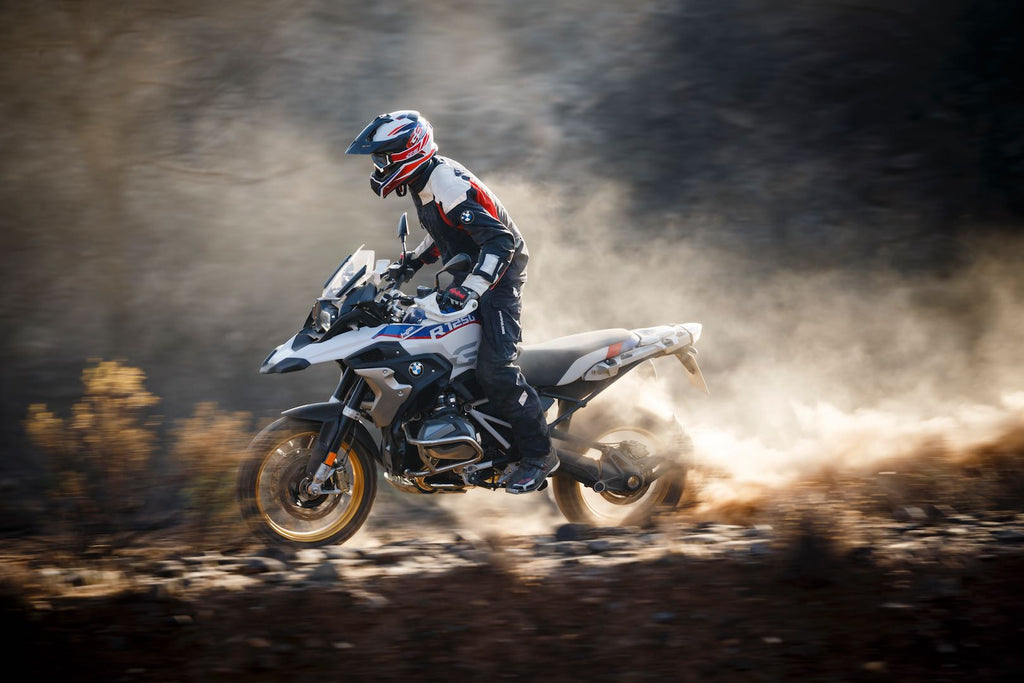BMW R 1250 GS vs F 850 GS: Which One Is Better For Me?

There’s an old saying among gearheads and it’s one you’ve likely heard: There’s no replacement for displacement.
In this “bigger is better” world we live in, we place value in excess. And while there’s nothing necessarily wrong with having the biggest this or the most of that, sometimes having less is the answer.
Especially when it comes to Adventure motorcycles.
Take the BMW R 1250 GS and F 850 GS. The BMW GS name needs no introduction, of course. It’s basically the granddaddy of the ADV class.
In more recent times, the big GS–now the 1250, but formerly the 1200 and 1150 versions before it–has shocked the motorcycling world with how capable it is. But the fact remains that the R 1250 GS is a large motorcycle, still unruly for some to handle.
This is where the F 850 GS comes in. Smaller, lighter, and more manageable, at 853cc, the little GS carries nearly 400cc less displacement with an accompanying weight reduction to match.
To answer this question, let’s do a breakdown of each model, comparing and contrasting their features.
Once you have a better understanding of what each model is–and is not–hopefully you can make a more informed decision.

BMW R 1250 GS
The R 1250 GS really needs no introduction. Clearly, if you’re reading this then you understand that. So let’s jump straight into the major difference between it and the 850 GS: the engine.
BMW’s 1254cc horizontally-opposed Boxer engine is quite a feat of engineering, especially when you consider that despite the fact the cylinders stick out as far as they do, GS riders aren’t afraid to go nearly anywhere with it.
This latest version showcases how much BMW continues to innovate with it. With a 102.5mm bore and 76mm stroke, those are some big pistons moving quite a bit.
But the really clever bits are found in the cylinder head, as this is the first of BMW’s Boxer engines to come with ShiftCam technology, or what is more commonly referred to as variable valve timing.
ShiftCam works in roughly the same way as other VVT systems, with two cam lobes per intake valve and an actuator that selects between the two.
The smaller cam only slightly opens the valve, which gives ideal low-rpm performance and mileage. At high rpm the larger cam is selected, fully opening the valve to deliver maximum performance.
That’s not all. The valves themselves open at slightly different times and not all at once. This helps to swirl the air-fuel mixture for more efficient combustion. BMW says the engine makes 136 hp and 105.5 lb-ft of torque; great numbers in itself, made better knowing how broad the spread of power is thanks to the ShiftCam tech.
The Downside
The downside here, at least to some, is the sheer size of the big GS. Coming in at 549 lbs on BMW’s scales, the 1250 GS has a standard seat height of 33.5 inches, though that can range anywhere from 31.5 inches to 34.3 inches depending on the suspension package. It’s nearly 87 inches long and 37.5 inches wide. It’s a hefty bike, even though we all know it carries its weight well.
Adventure
Jump to the R 1250 GS Adventure and everything levels up once more. Designed to truly let you get lost and find your way back, the two big differences here are the huge 7.9-gallon fuel tank (compared to 5.3 gallons on the standard GS) and slightly more suspension travel.
With a full tank, the Adventure tips the scales at 591 lbs and its seat is 35 inches from the ground. It’s also two inches longer than the standard GS and an inch wider. If you’re short, you definitely should think twice–maybe three times–if the Adventure is right for you.
Electronics
Loads of tech can be found on the big GS. It would take a book to detail all the features, but here are the highlights.
- 6.5-inch TFT display with the ability to connect to your phone or navigation device.
- Hill Start Control
- Dynamic Brake Control
- Dynamic ESA
- Ride Modes Pro
- Gear Shift Assist Pro
Price
Maybe, just maybe, the deciding factor when it comes to which bike is right for you is simple: price. The standard R 1250 GS starts at $17,895, but that number can skyrocket thousands of dollars more depending on options and packages.
The starting point is even higher if you opt for the GS Adventure: $20,195.

F 850 GS
That brings us to the F 850 GS, BMW’s offering in the popular middleweight adventure category. It seems nearly every manufacturer has a motorcycle in this category now, and for good reason–these motorcycles are much more manageable and every bit as capable.
So, like the R 1250 GS, let’s break down the F 850 GS starting with, what else, the engine.
Instead of a Boxer engine, the 850 is a parallel-twin measuring 853cc with four valves per cylinder and dual overhead camshafts, putting out 90 horsepower and 63 ft/lbs of torque. A big change compared to the F 800 GS this bike is replacing is the new firing order.
The 270-degree firing interval is the result of crankpins offset by 90 degrees. You notice that in the sound of the bike, but also in how the power is put to the ground.
The Downside
It’s a struggle to really call 90 horsepower and 63 ft/lbs of torque a downside in this case, but the people in the “bigger is better” camp might see it that way. Otherwise, when you look at the dimensions of the little GS, you can see why it’s appealing to some. Weighing in at 504 pounds, ready-to-ride, that’s nearly 100 less than the 1250.
Somewhat surprisingly, the little GS is longer than its big brother at 90.8 inches. But it’s 36.3-inch width is more than two inches narrower. Seat heights range from 32.1 inches to 35 inches, but the standard setting is 33.9 inches–comparable to the 1250 GS. Finally, some might frown at the 850’s four-gallon fuel capacity.
Adventure
If that sounds like you, then upgrading to the F 850 GS gets you a 6.1-gallon tank. Like the 1250 Adventure, the 850 version leans decidedly more towards the adventure spectrum, with its generous amounts of suspension travel–9.1 inches in the front, 8.5 inches in the rear.
It also comes with an adjustable touring windscreen, comfort seat, engine guards, and a stainless steel luggage rack (but the luggage is optional). Whether on-road or off, the F 850 GS Adventure, like the 1250 Adventure, is meant to take you away–and bring you back–in ultimate comfort.
The Adventure does all this without a major difference in overall dimensions. The length and width are basically identical to the standard model, and the comfort seat sits 34.4 inches off the ground. The bigger gas tank does up the weight a little, to 538 pounds. A fair tradeoff.
Electronics
One of the nice things about the F 850 GS is that it skimps on virtually nothing compared to the 1250 GS in terms of electronics. Here’s a rundown of its features:
- Rain and Road ride modes standard. Pro and Dynamic ESA modes optional. Optional ride modes for the Adventure include Enduro and Enduro Pro.
- Automatic stability control (ASC) aka Traction Control.
- Bluetooth connectivity to your phone and activation via the multi-controller, all seen through the same 6.5-inch TFT display on the 1250 GS (optional).
- Gear Shift Assist Pro
- ABS (ABS Pro optional)
Price
The great divider, the cost may be what ultimately separates the 1250 from the 850 for the discerning rider. Starting at $13,345, the standard 850 GS comes in far less than the 1250.
The 850 Adventure is only $1100 more at $14,445. While more affordable, nobody ever buys a standard BMW. Opt for the fully outfitted Premium Package for an extra $3450, and you’re looking at an 850 GS for more than $17,000.

Concluding Thoughts
One way to look at this is that a fully-kitted $17,000 F 850 GS will get you anywhere and do anything you could want on a GS, for the starting price of a R 1250 GS.
However, there’s an argument to be made about the 1250 truly being able to do it all while leaving nothing on the table from a performance perspective. The decision is up to you. Now that you’re armed with this information, which would you pick?